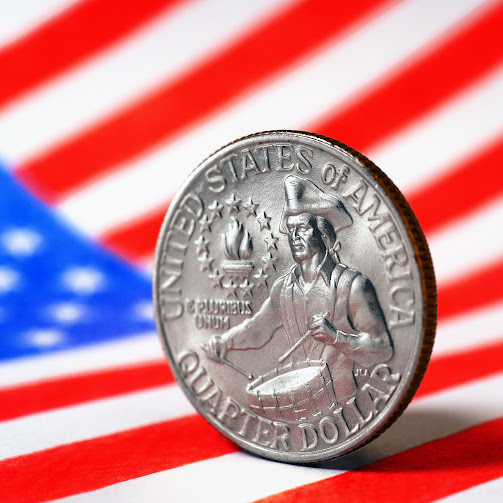The 1970s was also a time of great triumphs. Disco ruled the dance floor, while bellbottoms ruled the fashion world. The United States had just landed a man on the moon. Videocassettes and video games started to appear in more and more homes. The first personal computer was developed and marketed by IBM. Medical advancements included MRIs and the artificial heart.
Perhaps the biggest celebration the world has ever seen began its planning stages in the early 1970s. A multi-year event to celebrate the Bicentennial anniversary of the signing of the Declaration of Independence swept the country. In addition to parades and souvenirs, the Treasury of the United States issued its first circulating commemorative coin.
How They Decided The Design;
Secretary of the Treasury George P. Schultz directed Mrs. Mary Brooks, Director of the Mint, under the auspices of Public Law 93-127 to design three new coins emblematic of the Bicentennial of the American Revolution and to begin production on July 4, 1975. The three coins chosen to proclaim the bicentennial were the quarter, half-dollar, and one-dollar coin.
The people of the United States had not seen a commemorative coin since 1954 when the Treasury Department discontinued the commemorative coin program due to abuses by politicians and special interest groups. The excitement for the Bicentennial celebration fueled interest in these new coins. The Treasury Department asked the National Sculpture Society to conduct a design contest among its nationwide membership, impanel a jury of experts to judge the entries, and submit several designs for each denomination to the Secretary of the Treasury.
Collecting These Coins;
Since over 1.6 billion Bicentennial quarters were made between the Philadelphia and Denver United States Mint facilities, they are still occasionally found in circulation. Many United States citizens thought that these coins would be valuable in the future since they were commemorating the 200th anniversary of the signing of the Declaration of Independence. Therefore, gem uncirculated specimens can sometimes be found in pocket change because somebody cashed in the coins they've been hoarding since 1976. Additionally, nice collector-quality coins can be purchased from your favorite local coin dealer or on the Internet.
Although business strike coins made for circulation are plentiful, high-quality nicely-struck coins are hard to come across. Remember, the mint was under intense pressure to produce as many bicentennial coins as possible due to the likelihood of hoarding. Therefore, they sacrificed quality to gain quantity. When selecting a coin for your collection, look at the high points on Washington's cheek to ensure there is no evidence of wear and that the coin is fully struck. On the reverse side, look for weakness and lack of detail at the top of the drum. Coins with minimal surface scratches, dazzling mint luster, and excellent eye appeal are necessary for any outstanding coin collection.
Coins made specifically for collectors include the Proof copper-nickel clad, uncirculated 40% silver quarters, and Proof silver quarters. Since the mint manufactured these coins with great care, scratches and surface damage are rarely a concern. However, many Proof coins made with fatigued dies had diminished the intensity of the frosting on the devices and reduced the cameo contrast. Look for coins with deep frosting on the devices and extreme reflectivity on the mirror-like fields.
Unfortunately, many people did not store their special collector edition coins properly over the years. Many collectors and individuals purchased them directly from the United States Mint and then stored them in less than ideal conditions. This may have included boxes that ended up in attics and basements. The extreme temperatures and moisture in these areas can cause toning and corrosion on the coin's surface. Avoid purchasing any coin that has a haze on the coin's surface.


No comments:
Post a Comment